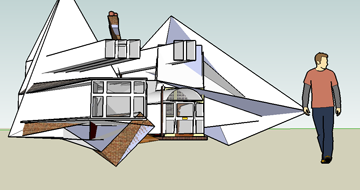
Nicholas O'Brien, Untitled still from an ongoing project made with Google SketchUp, 2009.
I thought before I get really started the guest blogging here, I’d speak a little bit about my intentions/directions/plans. BEFORE that, however, I’d like to thank Kelly Shindler for giving me this great opportunity as well as fellow Art21 bloggers and staff for their continued efforts and insight.
Although I hope not to linger too often on my own personal work while blogging here, I feel the need to provide slight context for what I will hopefully discuss. The easiest way I see myself establishing this context is through a brief examination of what I’m working on.
My academic and artistic practice (and these should be seen as being mutually influential or one in the same) filters through many sub-genres of what has often times been commonly dubbed newMedia Art (I prefer this spelling for reasons I might get into during my visit). Although I am sometimes in conflict with this classification and its specificity for mostly digitally-based artworks (according to some), I find it to be the most appropriate genre for me to identify with. Although my work encompasses Super-8mm film, photography, sound, performance, video, video games, and installation, I still feel most at home with wanting to associate with newMedia, even when the medium in which I’m working in is not often considered part of this genre, or even particularly “new.” In other words I feel as though newMedia is based more on ideology than on technology.
Nicholas O'Brien, Untitled still from a video sketch made in 2009.
With this in mind, what draws me to newMedia, and what I will be hopefully discussing her , is its possibility for multidisciplinary production. Recently, one primary concern deals with “the virtual.” In typical newMedia art narratives, the virtual is a common semantic replacement for cyberspace, or more simply the WWW. For my practice, however, I’m more interested in how/why this notion of the virtual has been primarily limited to digital experiences in cyberspace. In doing so, this bracketing overlooks a larger art historical discourse concerning representation in general being a virtual process. Virtuality extends beyond cyberworlds, refracting into different prisms; sculpted space, identity politics associated to land(scape), and memory. I feel as though we’re now seeing that the re-translation of virtual experience into physical manifestations is in disproportion to the initial transcription of ourselves into virtual realms; the machine is imperfect, the input is not (or is no longer) equal to the output. Our virtual selves contain more substance than our fleshy counterparts. We embody our tech more than we do our organs. To quote Erik Davis, “We have been cyborgs since year zero.”
Although I’m speaking somewhat abstractly (let’s get used to it), I plan on discussing these discrepancies through looking at works that are personally influential, as well as ones that represent/exemplify several stances on reconsidering the relationship between virtual spaces. Some approaches to this agenda include conversing about obsolescence (physical and cultural), art games/indie games, the disintegration/fabrication (a mutually implicated binary for me) of architectural space, rediscovering/reconsidering Home, reprogramming media myths, and exploring alternative histories(hystories) for newMedia Art.
Nicholas O'Brien, composite still from the Half-Life2 Game engine, made in 2009.
That all being said, one of the most distinct ways that I choose to trudge through this swampy mire is through Play. I love discussing Play (note capitalization, please) as an abstract ideal of cultural production. Play is enabling, empowering, and distinct in that it allows for a type of cultural liquidity that is hard to find in stringent artmaking. How can lolCats, OULIPO, Voltron, Half-Life2, and Philip Glass all be put on the same cultural pedestal without determining each element as pejoratively more or less culturally important? I’m not necessarily going to be providing answers for this, but I feel as though attempting to ask the question is testament to the subject material that I address in my work. The polymorphic significance of these different zones relate to the cultural leveling Barthes proposes in his examination of Wrestling (in Mythologies). I wish not to just analyze or observe anthropologically, I wish to engage (both skeptically and in celebration) how these environments or frameworks encourage and reinforce the importance of Play. To be able to weave through, without misappropriating/misrepresenting, these various lo(l)cals of Play is something that I hope I’m able to convey during my time with Art21.